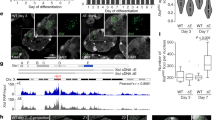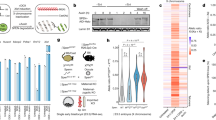Abstract
The gene Xist initiates the chromosomal silencing process of X inactivation in mammals. Its product, a noncoding RNA, is expressed from and specifically associates with the inactive X chromosome in female cells. Here we use an inducible Xist expression system in mouse embryonic stem cells that recapitulates long-range chromosomal silencing to elucidate which Xist RNA sequences are necessary for chromosomal association and silencing. We show that chromosomal association and spreading of Xist RNA can be functionally separated from silencing by specific mutations. Silencing requires a conserved repeat sequence located at the 5′ end of Xist. Deletion of this element results in Xist RNA that still associates with chromatin and spreads over the chromosome but does not effect transcriptional repression. Association of Xist RNA with chromatin is mediated by functionally redundant sequences that act cooperatively and are dispersed throughout the remainder of Xist but show little or no homology.
This is a preview of subscription content, access via your institution
Access options
Subscribe to this journal
Receive 12 print issues and online access
$209.00 per year
only $17.42 per issue
Buy this article
- Purchase on Springer Link
- Instant access to full article PDF
Prices may be subject to local taxes which are calculated during checkout






Similar content being viewed by others
References
Barr, M.L. & Bertram, E.G. A morphological distinction between neurones of the male and female, and the behaviour of the nucleolar satellite during accelerated nucleoprotein synthesis. Nature 163, 676–677 (1949).
Avner, P. & Heard, E. X-chromosome inactivation: counting, choice and initiation. Nature Rev. Genet. 2, 59–67 (2001).
Lyon, M.F. Gene action in the X-chromosome of the mouse (Mus musculus L.). Nature 190, 372–373 (1961).
Russell, L.B. Genetics of mammalian sex chromosomes. Science, 1795–1803 (1961).
Brown, C.J. & Willard, H.F. Localization of the X inactivation center (XIC) to Xq13. Cytogenet. Cell. Genet. 51, 971 (1989).
Brown, C.J. et al. A gene from the region of the human X inactivation centre is expressed exclusively from the inactive X chromosome. Nature 349, 38–44 (1991).
Brockdorff, N. et al. Conservation of position and exclusive expression of mouse Xist from the inactive X chromosome. Nature 351, 329–331 (1991).
Brown, C.J. et al. The human XIST gene: analysis of a 17 kb inactive X-specific RNA that contains conserved repeats and is highly localized within the nucleus. Cell 71, 527–542 (1992).
Marahrens, Y., Panning, B., Dausman, J., Strauss, W. & Jaenisch, R. Xist-deficient mice are defective in dosage compensation but not spermatogenesis. Genes. Dev. 11, 156–166 (1997).
Penny, G.D., Kay, G.F., Sheardown, S.A., Rastan, S. & Brockdorff, N. Requirement for Xist in X chromosome inactivation. Nature 379, 131–137 (1996).
Lee, J.T., Strauss, W.M., Dausman, J.A. & Jaenisch, R. A 450 kb transgene displays properties of the mammalian X-inactivation center. Cell 86, 83–94 (1996).
Herzing, L.B., Romer, J.T., Horn, J.M. & Ashworth, A. Xist has properties of the X-chromosome inactivation centre. Nature 386, 272–275 (1997).
Wutz, A. & Jaenisch, R. A shift from reversible to irreversible X inactivation is triggered during ES cell differentiation. Mol. Cell. 5, 695–705 (2000).
Marahrens, Y., Loring, J. & Jaenisch, R. Role of the Xist gene in X chromosome choosing. Cell 92, 657–664 (1998).
Rasmussen, T.P., Wutz, A., Pehrson, J.R. & Jaenisch, R. Xist expression is sufficient for macroH2A localization. Chromosoma 110, 411–420 (2001).
Brockdorff, N. et al. The product of the mouse Xist gene is a 15 kb inactive X-specific transcript containing no conserved ORF and located in the nucleus. Cell 71, 515–526 (1992).
Tinker, A.V. & Brown, C.J. Induction of XIST expression from the human active X chromosome in mouse/human somatic cell hybrids by DNA demethylation. Nucleic Acids Res. 26, 2935–2940 (1998).
Bronson, S.K. et al. Single-copy transgenic mice with chosen-site integration. Proc. Natl Acad. Sci. USA 93, 9067–9072 (1996).
Fukushige, S. & Sauer, B. Genomic targeting with a positive-selection lox integration vector allows highly reproducible gene expression in mammalian cells. Proc. Natl Acad. Sci. USA 89, 7905–7909 (1992).
Baron, U., Freundlieb, S., Gossen, M. & Bujard, H. Co-regulation of two gene activities by tetracycline via a bidirectional promoter. Nucleic Acids Res. 23, 3605–3606 (1995).
Gossen, M. et al. Transcriptional activation by tetracyclines in mammalian cells. Science 268, 1766–1769 (1995).
Zambrowicz, B.P. et al. Disruption of overlapping transcripts in the ROSA β geo 26 gene trap strain leads to widespread expression of β-galactosidase in mouse embryos and hematopoietic cells. Proc. Natl Acad. Sci. USA 94, 3789–3794 (1997).
Lee, J.T., Davidow, L.S. & Warshawsky, D. Tsix, a gene antisense to Xist at the inactivation centre. Nature Genet. 21, 400–404 (1999).
Costanzi, C. & Pehrson, J.R. Histone macroH2A1 is concentrated in the inactive X chromosome of female mammals. Nature 393, 599–601 (1998).
Rasmussen, T.P., Mastrangelo, M.A., Eden, A., Pehrson, J.R. & Jaenisch, R. Dynamic relocalization of histone MacroH2A1 from centrosomes to inactive X chromosomes during X inactivation. J. Cell. Biol. 150, 1189–1198 (2000).
Csankovszki, G., Panning, B., Bates, B., Pehrson, J.R. & Jaenisch, R. Conditional deletion of Xist disrupts histone macroH2A localization but not maintenance of X inactivation. Nature Genet. 22, 323–324 (1999).
Nesterova, T.B. et al. Characterization of the genomic xist locus in rodents reveals conservation of overall gene structure and tandem repeats but rapid evolution of unique sequence. Genome Res. 11, 833–849 (2001).
Karn, J. et al. Control of immunodeficiency virus gene expression by the RNA-binding proteins tat and rev. in RNA-Protein Interactions (eds Nagai, K. & Mattaj, I.W.) 192–220 (Oxford University Press, New York, 1994).
Beletskii, A., Hong, Y.-K., Pehrson, J., Egholm, M. & Strauss, W.M. PNA interface mapping demonstrates functional domains in the noncoding RNA Xist. Proc. Natl Acad. Sci. USA 98, 9215–9220 (2001).
Allaman-Pillet, N., Djemai, A., Bonny, C. & Schorderet, D.F. The 5′ repeat elements of the mouse Xist gene inhibit the transcription of X-linked genes. Gene. Expr. 9, 93–101 (2000).
Kelley, R.L. & Kuroda, M.I. Noncoding RNA genes in dosage compensation and imprinting. Cell 103, 9–12 (2000).
Soriano, P. Generalized lacZ expression with the ROSA26 Cre reporter strain. Nature Genet. 21, 70–71 (1999).
Baron, U., Gossen, M. & Bujard, H. Tetracycline-controlled transcription in eukaryotes: novel transactivators with graded transactivation potential. Nucleic Acids Res. 25, 2723–2729 (1997).
Wutz, A. et al. Non-imprinted Igf2r expression decreases growth and rescues the Tme mutation in mice. Development 128, 1881–1887 (2001).
Acknowledgements
We are grateful for the ability to use the microscopes of the W.M. Keck Biological Imaging Facility. This work was supported by grants from the National Institutes of Health and the Max Kade Foundation, and by the Human Frontiers Science Program Organization.
Author information
Authors and Affiliations
Corresponding author
Rights and permissions
About this article
Cite this article
Wutz, A., Rasmussen, T. & Jaenisch, R. Chromosomal silencing and localization are mediated by different domains of Xist RNA. Nat Genet 30, 167–174 (2002). https://doi.org/10.1038/ng820
Received:
Accepted:
Published:
Issue Date:
DOI: https://doi.org/10.1038/ng820
This article is cited by
-
Unraveling the role of Xist in X chromosome inactivation: insights from rabbit model and deletion analysis of exons and repeat A
Cellular and Molecular Life Sciences (2024)
-
RNA polymerase II depletion from the inactive X chromosome territory is not mediated by physical compartmentalization
Nature Structural & Molecular Biology (2023)
-
Multiple distinct domains of human XIST are required to coordinate gene silencing and subsequent heterochromatin formation
Epigenetics & Chromatin (2022)
-
Xist spatially amplifies SHARP/SPEN recruitment to balance chromosome-wide silencing and specificity to the X chromosome
Nature Structural & Molecular Biology (2022)
-
Phase separation drives X-chromosome inactivation
Nature Structural & Molecular Biology (2022)



